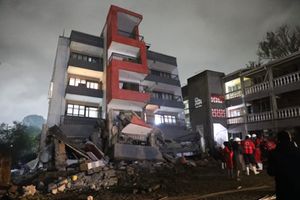The sanctuary amid the hills

A section of Subukia viewed from the top of of Morro Hill. The town sits in a depression and is surrounded by hills. PHOTO| WILLIAM RUTHI
What you need to know:
- Then I saw it. There, in the distance, atop Morro Hill, rising up to meet the low-hanging clouds was a giant cross.
- It glinted in the morning sun, touching the hills with some magic and cueing me to fetch my camera and spiral. What could be up there?
- Who erected that lone cross?
The Subukia-Nyahururu road curves its way down the undulating landscape of Subukia, Nakuru County. It is a breathtaking view; in the distance, down the valley, the land stretches endlessly.
Then you see it. One of the most jarring, beautiful, majestic sights you can ever encounter in the business end of a camera lens, close-up or long-range, It is the national Marian Shrine, the venerable retreat and prayer centre run by the Catholic church.
The shrine, cut into the side of a densely-wooded hill about 10 kilometres from the tarmac, sits kingly amidst the trees. With its distinct architecture, a white cross rising skywards from among the trees, its brick-red cone roof is a marvel.
Accounts by many of the thousands of pilgrims who ascend the hill throughout the year say it is a place of healing and introspection, and for the weary, a place where one can lay down one’s burdens.
THE CROSS
Several miles away on the opposite side of the shrine is a flat-topped hill. Sitting thousands of feet above Subukia town, the hill, once briefly known by as Edgewood, but now renamed Morro, stretches along the skyline as if to meet the sky.
Denuded of trees and grandeur, the hill probably wouldn’t be mentioned alongside the grand edifice of the Marian, but for the symbol that universally identifies the Christian faith: a cross.
I took a trip to the area on Boxing Day, that holiday between merrymaking and the looming work week. I had been to Subukia before, but I hadn’t taken time to look around. The sun was already up, but life hadn’t rustled quite yet.
Then I saw it. There, in the distance, atop Morro Hill, rising up to meet the low-hanging clouds was a giant cross. It glinted in the morning sun, touching the hills with some magic and cueing me to fetch my camera and spiral. What could be up there? Who erected that lone cross?
On the way up, I met only one person, a wiry man descending the hill. He nodded a greeting, and I wondered whether he had been to the top. All elevated places allow entry only grudgingly – there is a steep cost to it: the pulse rate runs amok, the calf muscles cry out for succor, but once you’ve earned the right, the welcome is worth the trouble. I climbed the rocky trail, stopping to catch my breath but never looking back at the distance I had covered, never looking at the watch; just one foot after the other.
The hill is the closest to Golgotha, that terribly sad of all hills in Biblical lore, where Christ ascended while carrying his own cross. It is with this in mind—a recreation of the gospel account of the crucifixion— that the local Catholic diocese commissioned technicians to weld two thick nail-like steel poles into a cross, and planted it into the ground.
The end of the climb opens out to an open, grassy field, and what was the horizon, the skyline shifts, pulling back to meet other hills. And to my surprise, a village; I hadn’t imagined there might be a settlement at such an attitude.
The cross, its lower part painted white, steeples the air at nearly 100 feet, at its base a collection of rocks amongst which lizards scurry about. Sitting at its foot, I understood why Subukia is widely considered a bastion of religious-tourism. The Marian Shrine in the timbered hills and the lone cross at the crest of the flat hill appear ideal: seclusion and emptiness.
And like all places that somehow always-irretrievably drive visitors to mark their presence, the cross is etched with graffiti: names, mostly.
“It is the ‘Way of the Cross’”, Dickens Mwai, a local man explained to me later; the concept in Catholic liturgy where believers re-enact Christ’s ascension to Golgotha. It’s a major pull during Easter.
THE LAND OF THE HILLS
The Masai people named this land Isipuku, meaning hilly land, but as with several other places bearing native names that were anglicised, Isipuku became Subukia. Now as I sat atop the hill, I understood why the Masai gave the land its name. Subukia, the town and surrounding villages, sit in a depression, while up above, a gaggle of hills stretch as far as the eyes can see, standing guard like a fortress.
Down the hill, the land rolled on forever. Wisps of smoke curled up from homesteads, roofing gleaming in the reddening sun. But seen from the hilltop life appeared a world away, the usual bustle of life a hazy collage. For a moment the large cross didn’t summon or represent pain, suffering; it didn’t even conjure images of religious foundation or revival. It was simply a place apart, a safe place away from bills and fumes and the thudding rush of life.
Which made sense – the stories of all shrines.
Soon, three boys approached, haltingly at first. Nodding them over, it took just a few minutes before we were chatting like long-lost friends. Curious, they wanted to know where I was from, what had brought me to the Hill.
“Tell me what you know about this place,” I suggested.
They snickered before the tallest of them said with boyish enthusiasm, “Well, I can climb up the pole. We do it all the time!”
We had a laugh about it and then they stood for a picture next to the cross.
When I rose to leave, I looked at the rocks at the foot of the metal one last time; the lizards capered without a care, down crooks between the rocks and out, amongst the prayers left behind. I looked up at the cross, and it occurred to me that the scudding clouds appeared ominously close, thick. I swept over the land, over the barren craggy hills. Leaning against the cross and I knew why it was worth climbing up the hill: It was beautiful beyond any song.
Back on earth, I gazed up the cross for one last look. The other shrine, shining in the afternoon sun, appeared as magnificent as the Marian Shrine. Even without the trees.
Come Easter, pilgrims ascend the Morro Hill to leave their burdens and notes among the rocks, descending with a reel of pictures, the obligatory selfie.




